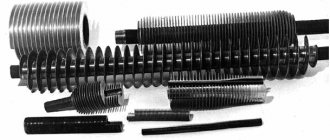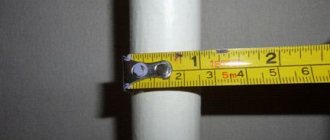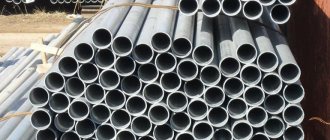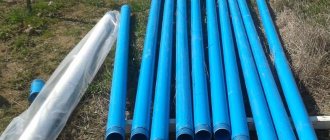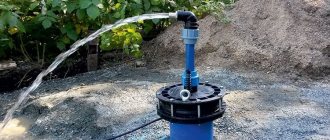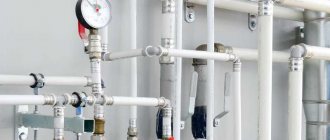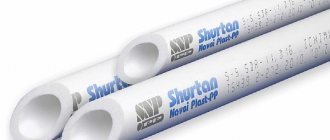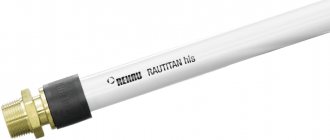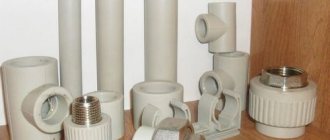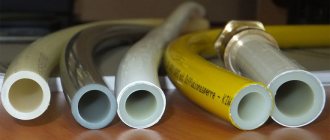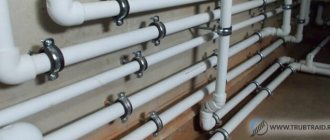Those who are faced with the choice between seam and seamless pipes for the first time may find it difficult. There is a high risk of buying a pipe that does not meet the desired loads, or of overpaying. In addition, seam and seamless pipes can differ in various parameters. For example, manufacturing technology.
It is worth paying attention to the steel grades used in production. The most popular are 0-20, 3PS/SP5, 09G2S and 17G1S. In this article we will tell you what the main differences between seam and seamless pipes are and how they can be used.
How to distinguish a seamless pipe?
The question rarely arises of how to distinguish a seamless pipe, because it has a completely smooth surface without seams left after welding. To ensure the required strength characteristics, low-carbon stainless steels are most often used. Metal rolling is performed using:
- special equipment;
- hot and cold forging;
- pressing;
- drawing.
Regardless of the method used, the result is a durable product with a hole of the required diameter in the middle. The use of steel with different characteristics and various production methods makes it possible to make a seamless pipe durable and resistant to external damage, including thermal and climatic overloads.
The advantages of such products are:
- extremely high strength;
- resistance to internal pressure;
- optimal protection against corrosion due to the absence of a welded seam.
The price of seamless pipes is slightly higher than electric welded pipes, but they are used where reliability and high strength of the product are required.
Electric welded pipes
Such products are made from rolled sheets made using carbon or low-alloy steels. To begin with, the blanks are shaped, and then the individual parts are welded into a whole structure. The joint always runs parallel to the axis of the pipe, which allows you to get a perfectly even seam running straight. Electric-welded pipes are manufactured in various shapes:
The difference between seamless and electric-welded pipes is that they can have a straight or spiral seam. In the second case, the steel tape is applied in a spiral, which allows you to give the product the desired look.
Electric-welded pipes are often used in gas pipelines, heating systems, water supply systems and other places where increased demands are placed on the quality of steel in pipes. Modern welding methods make it possible to increase the durability of products while maintaining their versatility.
Source
And more about pipes
- The reliability and safety of pipelines depends on the strength characteristics of the materials used, these are: strength, ductility, creep.
- It should be noted that the production of electric-welded pipes is simpler, so the price of finished products will be noticeably lower. Electric-welded longitudinally welded pipes can be manufactured with a diameter of up to 1500 mm , and spiral-welded pipes with a diameter of up to 2520 mm .
- Seamless pipes are produced with a diameter much lower than these indicators.
- For laying water supply networks and heating systems that do not have high pressure, it is more advisable to use electric welded pipes , provided that they are of good quality, manufactured in accordance with GOST.
- To transport hazardous media or media with high operating pressure, in critical areas where access is difficult, only seamless pipes .
Preference is given to rolled pipes that meet operating conditions and efficiency of use. In any case, the choice of pipes will depend on the conditions of the task facing the designers.
Repair and constructionComment
Differences between seamless pipe and electric welded pipe
A seamless pipe is a solid metal structure in the shape of a cylinder. The main feature of this type is the absence of seams on the surface. Depending on the production method, they are divided into:
The main differences between finished products are the list of standard sizes and the possibilities of their use in various fields. For example, cold rolling makes it possible to achieve more accurate and small dimensions, as well as better surface quality of the metal.
Seamless products have high strength indicators, so they are often used in conditions with high loads. The products also withstand mechanical stress and temperature fluctuations.
An electric-welded pipe is a metal structure with a longitudinal seam, which is made from rolled sheets or strips. They are used everywhere: in construction, furniture production, as a consumable material in the production of other metal products, in the improvement of the city - railings, canopies, public transport stops, etc. In different areas, rolled pipes with different seams and cross-sections (round, square) are used.
So there are two types of seams:
- Straight-seam, where the fastening is carried out parallel to the axis.
- Spiral welding, where welding is carried out in a spiral. It is considered more reliable and durable.
The cost of welded products is significantly less than that of products without a seam. Therefore, if operating conditions allow their use, then preference is given to welded ones.
Characteristics of seamless rolled metal
Pipes made by hot rolling must comply with the regulations - GOST 8732-78. This regulation was developed and introduced by the USSR Ministry of Ferrous Metallurgy and is an interstate standard.
It specifies the assortment, steel grades, maximum deviations, lengths, and formulas for calculating weight. According to the standards, the main indicators can have the following values:
- Outer diameter from 20 to 550 mm;
- Wall thickness from 2.5 to 75 mm.
Cold-rolled pipes are produced according to the standard - GOST 8734-75. It also spells out the main characteristics: product range, steel grade, lengths, formulas.
- The outer diameter ranges from 5 to 250 mm;
- Wall thickness – from 0.3 to 24 mm.
There are several subtypes here, depending on the thickness d and h. These include:
- Extra-thin-walled;
- Thin-walled;
- Extra thick-walled;
- Thick-walled.
The document was approved and put into effect by the Resolution of the State Committee of Standards of the Council of Ministers of the USSR. It is also an interstate regulation.
Characteristics of electric welded pipes
In addition, each type of seam corresponds to a separate regulatory document. Thus, for straight-seam welded steel, GOST 10704-91 and 10706-76 have been developed. The outer diameter according to this standard is manufactured from 10 to 1420 mm, and the wall thickness is from 0.8 to 30 mm.
For spiral seams, GOST 8696-74 applies. According to it, diameter values can be from 159 to 2520 mm, and wall thickness - from 3.5 to 25 mm.
What are the differences between these types?
The main difference lies in the method of manufacture and subsequent operation.
Electric welded ones, due to their technology, can leak at the welding site. Therefore, special installation conditions are applied to them, under which it is possible to weld the fistula. For the same reason, higher requirements for metal quality are put forward to them.
However, their production is much cheaper, and the production time is much shorter. In addition, their assortment is quite diverse, since the technology does not imply size restrictions, which cannot be said about seamless ones; their maximum size is much smaller. But one of the advantages they have is a longer service life. They can be used in environments with aggressive environments, high temperatures and pressure. This important circumstance makes them indispensable in many industries.
Electric welded
Electric welded products are valued for their versatility of use . This primarily applies to round products that are successfully used by industrial enterprises and construction corporations.
They are widely used in laying pipelines, making furniture and creating interiors for residential and commercial spaces. Electric-welded pipes are often used as a consumable material for the manufacture of various products. Steel sheet or strip are used as raw materials.
Depending on the type of seam, they can be straight-seam or spiral-seam .
Straight-seam
- Manufacturing begins with cutting sheet steel into blanks of equal thickness , which subsequently ensures the convergence of the edges when forming the blank.
- Rolls are used to straighten to eliminate waviness and other defects.
- Using semi-automatic submerged arc welding or tungsten electrodes in an inert gas environment, the strips are connected .
- To form the product, the strip is passed through a series of horizontal and vertical rolls . Each subsequent pair of rolls reduces the diameter of the semi-finished product until the strip edges converge as much as possible.
- High frequency currents are used to weld a longitudinal seam . The edges of the strip are heated to the melting temperature of the metal and pressed by rollers. And the result is a strong and reliable connection.
Spiral seam
The finished steel strips are wound at an angle onto a molder of a given size and, in the process of coming off the forming rod, the edges are welded in a spiral, on both sides under a layer of flux.
The use of inch pipes in various designs
When selecting material for their project, many are faced with the fact that it is difficult to find pipes of the required diameter on the open market. Most often, this problem occurs among those who live far from big cities or large metal depots. However, even if you have a large rental company nearby, this does not mean that it will be easy to buy a pipe of the required size. Most often, you will encounter the fact that the seller either does not work with individuals or does not ship products at retail, and is not ready to sell you less than 500-1000 kg. In this situation, there is nothing left but to go to the nearest construction market to get the necessary pipe.
Assortment of construction markets
Sellers working in construction markets sell only what is in demand during construction. Therefore, you will most likely be offered electric-welded (i.e., with a longitudinal weld) pipes. This is the most common type of round pipes used in the construction of buildings and structures, as well as in the arrangement of pipelines.
These pipes are also called using the abbreviation VGP, i.e. “water-gas pipeline” or use the letter DN in the designation (i.e. “conventional diameter”). They are also known as “inch”.
VGP pipes differ from seamless ones in that they have a longitudinal weld. It is required to undergo flaw detection during production, because VGP pipes are used in pipelines and must withstand pressures of more than 10 atmospheres. This means that welded pipes are strong enough to be used in most metal structures that do not have specific requirements.
Seamless
Blanks for seamless fabrication are manufactured at metallurgical enterprises and rolling shops. The difference in the production technology of pipe products lies in the operating temperatures of the processed raw materials. The main distinguishing feature of seamless products is their individual dimensional parameters .
Seamless products include products that do not have any joints. They have high strength indicators. Hot-deformed (hot-rolled) and cold-deformed pipe products are manufactured
Hot rolled
- The blank for the manufacture of the product is a cylindrical mold made of a monolith , which is heated to a given temperature and stitched with special equipment, resulting in the formation of a hollow configuration.
- By rolling the resulting workpiece, the desired size and geometry of the product is achieved.
- The workpiece is cooled and brought to the required caliber by the rolling process and cut into the required sizes.
Cold-worked
They are made in the same way. The difference lies in the cooling procedure , which is performed immediately after flashing on the equipment, and calibration is done when the workpiece is cooled.
How do VGP (DU) pipes differ from seamless ones?
In addition to the presence of a welded seam, VGP pipes have several other important differences from seamless pipes.
Firstly, most of the pipes on the construction market are made of St3 steel. It is the most common and cheapest structural steel. It does not have outstanding strength characteristics, so it is not used in the manufacture of particularly critical components. But it is cheap, and pipes made from it are also inexpensive.
For use in harsh climatic conditions, VGP pipes can be made of 09G2S steel, which is characterized by increased frost resistance. You can come across such pipes if you live in the northern regions of the Russian Federation. Steel 09G2S is stronger than St3, but is still inferior to the so-called. “quality steels” (St10, St20, etc.). GOSTs allow the production of VGP pipes from high-quality carbon steels ST10 or St20, but you are unlikely to find such a pipe on the construction market.
The second difference between VGP pipes and seamless ones is how their sizes are designated. This often creates confusion and confusion when planning structures. Below we will look at this point in more detail.
VGP pipe certificate: what is it and why is it needed?
A certificate issued to the manufacturing company is needed to protect the consumer from purchasing a low-quality product. The presence of a certificate of conformity indicates that this manufacturer adheres to all the standards prescribed in a specific GOST. It is interesting that the certificate of conformity for VGP pipes is issued on a voluntary basis: water and gas products are not subject to mandatory certification. Such a certificate is issued after passing tests in laboratory conditions, including hydraulic ones.
Important! If a certificate is issued for galvanized products, the document must indicate the galvanizing method - “hot” or “cold”.
Another document that has a positive effect on buyer confidence is a hygiene certificate. It includes a conclusion on passing a sanitary and epidemiological examination. The procedure is carried out in a limited time using standard expert techniques. The certificate received by the company applies to the entire range of products.
When choosing pipes for installation of a gas (water) pipeline system, it is necessary to proceed from the degree of compliance of the supplier’s capacities with the conditions of the state standard and from personal requirements. For household pipelines, it is advisable to use both galvanized pipes and black steel pipes. If the requirements for system operation are increased, then galvanized steel will be the best choice.
Seamless and welded pipes: production features
According to the manufacturing method, steel pipes are divided into two large categories:
- Seamless - products have a solid, uniform surface.
- Electric welded - samples are distinguished by the presence of a straight or spiral seam.
Seamless rolling is made using a hot or cold method from a hollow cylindrical billet. The steel sleeve is processed in different ways - forging, pressing, drawing. Excess parts are removed from the workpiece, leaving a solid shell of a certain thickness.
Welded products are bent from a flat steel sheet. The rolled product is given a closed shape - round or rectangular, and the joints of the connected ends are welded.
External differences
You can most often distinguish welded metal structures from rolled products without a seam by their appearance. The first ones have a straight or spiral seam along the entire length. Sometimes it is clearly visible visually and can be detected by touch. In some cases, the surface of the metal is ground smooth, so the seam is indistinguishable from the outside, visible only from the inside.
Dimensions of VGP pipes
VGP pipes are often designated by the letters “DN” followed by numbers indicating the size. They can also indicate the size in inches: 1/2″, 3/4″, 1 1/4″, etc. The numbers indicate the so-called. “conditional bore” is the approximate diameter (in mm or inches) of the inner part of the pipe. Not the outer diameter of the pipe, but the conditional (approximate) diameter of the passage hole. The picture below illustrates the difference:
This creates a lot of confusion. The actual size of the pipe bore depends on the thickness of its wall, and the outer diameter of the VGP pipe does not depend on the wall thickness and is constant for each standard size. This was done in order to unify the sizes of pipes and fittings with which they are connected (remember that the main purpose of VGP pipes is pipelines).
Areas of use
As operating practice shows, seamless aluminum pipes are divided according to application into the following types:
- On pipes designed for the flow of liquids and gases through them, which is carried out directly under high pressure. This will allow the structures to be used directly in various types of highways, where a particularly important indicator is to ensure anti-corrosion protection of the structure;
- High-strength pipes that are used to ensure the flow of various chemical compounds and components. A distinctive feature of these products is the strength and thickness of the walls, the presence of an additional coating, which can protect against corrosion of the structure and a number of other influences;
- Pipes that have a fairly high level of quality of external finishing, in particular, for these purposes it is decided to use a special anodic oxide coating. According to the specifics of operation, similar product names are actively used when installing pipelines along land lines, thereby ensuring a high level of aesthetics.
Important! The choice of a specific type of pipe is relevant if you first calculate all the conditions for subsequent operation. Each type of product is designed for its own operating conditions and can be used exclusively in these types of highways.
The use of inch pipes in various designs
As can be seen from the table above, inch pipes from 1/2″ to 1 1/4″ (VGP pipes from Du15 to Du32) have very similar dimensions to seamless pipes with a diameter of 22, 28, 34 and 42 mm. Thus, if you do not have the opportunity to purchase a seamless pipe at retail, it can be replaced with an inch pipe of similar size.
However, it must be remembered that VGP pipes are made of less durable material than seamless ones. In addition, VGP pipes have a thicker wall. This partially compensates for the difference in strength, but the structure made from such pipes will be heavier.
In most cases, you won't be able to replace the difference from replacing seamless pipes with VGP. However, avoid their use where the design requirements explicitly specify the use of seamless pipes made from a specific grade of steel.
VGP steel pipe: what is it?
Pipes classified by the abbreviation VGP are considered very durable and wear-resistant. Their rigidity is equal to the qualities of an all-metal beam of the same diameter. The purpose of the steel VGP pipe lies in the decoding of the name - “water and gas pipeline”. Accordingly, these products are used to create pipelines for gas and water: both domestic (domestic) and main ones.
The advantages of water and gas pipes include the following:
- low linear expansion rate. VGP pipes do not deform under the influence of temperatures approaching boiling water. They are able to withstand temperatures at which polymer materials begin to soften and melt. Also, the steel pipe does not deteriorate when the coolant (liquid) freezes;
- high strength. The strength indicators of VGP steel pipes are higher than those of copper and polypropylene products. Their limit of permissible internal pressure allows the use of steel pipelines in pressure networks. Galvanized VGP pipe is also resistant to corrosion;
- thermal conductivity. The media in steel pipes maintain the required temperature for a long time;
- tightness. Transportation of gaseous and volatile substances, as well as acids and other chemically active components is allowed.
Pipes made of ordinary steel and non-galvanized steel quickly become rusty
Important! On the other hand, high thermal conductivity can cause heat loss in the system, but this disadvantage can be easily overcome with insulating materials.
Basic properties
Seamless pipes are considered one of the most significant elements of industrial structures. High reliability of the equipped pipelines is guaranteed due to the absence of seams in the pipes. The products withstand mechanical stress quite well because they have very high performance characteristics.
The variety of manufactured products makes it possible to expand the range of applications of products. There are many types of seamless pipes in the domestic and foreign metal markets, differing in configuration, dimensions, shape, as well as the materials from which they are made. Depending on the type of cross-section, square, round or rectangular pipes are classified.
The use of seamless hot-rolled pipes requires fairly high reliability, so they are made as durable as possible.
According to the width of the walls, hot-rolled pipes are divided into:
In thick-walled pipes, the thickness of the metal layer reaches 12.5-40 mm. Thin-walled metal layers reach 6-12.5 mm. The accuracy of the outer diameter can be normal or increased.
The length of the seamless pipe ranges from 4 to 12.5 m.
Hot-formed products are made of special carbon alloy steel. For this reason, rolled metal products are highly resistant to corrosion and can be used in conditions of interaction with an aggressive chemical environment.
Experts distinguish several main classes of seamless pipes, distinguished by the properties of the metal used:
- With standardization of mechanical qualities;
- Chemical component;
- Mechanical and chemical components;
- Adjustment of the chemical composition of products that have not undergone preliminary heat treatment;
- Without chemical and mechanical regulation.
There are 5 main groups of hot-rolled products:
- A – with adjustment of mechanical characteristics;
- B – with adjustment of chemical characteristics;
- B – with mandatory adjustment of chemical and metal characteristics;
- D – adjustment of the chemical component and control of mechanical characteristics on samples;
- D – with adjustment of resistance to hydraulic pressure indicators.
Different classes of seamless pipes are endowed with individual technical characteristics and are used where such specificity optimally meets the operational needs of users. For example, thick-walled products are used for the construction of water and gas pipelines.
Seamless hot-rolled products are often used in the oil and gas industry, mechanical engineering, and utilities. Most of the rolled metal products manufactured in Russia and Belarus are exported from the country.
Seamless pipes made from solid metal ingots cannot be used to transport hazardous substances, flammable materials, or transport hot water or steam.
Difference in areas of use
Welded structures are reliable, but they cannot withstand extreme temperatures and high pressure. Such pipes are used to transmit steam, gas, water, and are installed in water supply lines, gas pipelines, heating networks of the private sector or industrial enterprises. Seamless pipes have increased strength and are resistant to aggressive environments, high temperatures and pressure. The absence of a seam increases their anti-corrosion resistance. They are installed on main heating mains for transporting oil, its products, gas, and chemicals.
engages in the sale of rolled metal and pipeline fittings, and also produces various metal products according to customer drawings. Our specialists will provide free information support on thematic issues and assist in selecting steel products that are suitable for the purpose, size, and configuration. By purchasing metal products from us, the customer is protected from the possibility of receiving counterfeits, defects or mismatches.
Steel pipes for heating: selection and installation
Before each heating season, owners begin to check the condition of heating devices, boilers, pipelines, and carry out preventive maintenance. If a malfunction is discovered, then they try to eliminate it before the weather gets colder; this requirement also applies to pipes, only with them everything is somewhat more complicated.
This is a separate device, for example a circulation pump, that can be easily dismantled to be repaired or replaced with a new one, but a section of pipeline cannot be replaced so easily. Usually they try to install plastic pipes, believing that steel ones have already lost their relevance, forgetting about the advantages of metal, about installation technology, and operation that has been proven over the years.
New materials used in the production of plastic pipes have good performance, but do not have the advantages of steel ones.
Plastic ones still need to be correctly selected, installed, and operated. So what should you choose?
Choice
A heating system that uses steel has always been considered reliable, durable, and able to withstand heavy loads. The reason why home owners refuse to install steel ones is considered to be the wrong choice, when pipes are taken for heating that are completely unsuitable for this purpose. As a result, the service life is short, and therefore they are replaced with plastic ones. There are simply several types of steel. Let's take a closer look.
The cheapest type of pipe is seam. Choosing this type is doomed to failure; its maximum service life will be several years. But why? First of all, this is manufacturing, when the pipe is not made solid, but welded, bent.
The place where the walls touch is connected by a weld seam processed on the outside, so that there are no nicks or irregularities, the entire surface is smooth. It is impossible to process such a seam from the inside; the quality of the seam is difficult to control, which is why a small flaw in the form of a shell allows the metal to leak in this place. A leak appears and the pipe needs to be replaced.
Another drawback is discovered during installation work. It is difficult to bend a pipe in a special machine to obtain the desired angle and contour. Usually the seam does not hold up at the bend and bursts. Preheating is required, but this does not improve the quality. The suture has a completely different purpose: it is suitable for air ducts under high pressure, for laying hidden wiring inside it, when the damaged area is easy to remove and insert a new one.
Seamless pipes are much more reliable. The recommended diameter for individual heating is 25 mm; of course, if necessary, the diameter is increased or, conversely, reduced, but according to the design and operating requirements. Recommended wall thickness 2.7 mm. Over the course of a year, the wall can decrease by 0.1 mm; the average operating rate, pressure is up to 10 atmospheres; during testing, they easily withstood even 20 atmospheres.
Therefore, steel pipes should last 15-20 years without problems. There are often cases when, when installing autonomous heating in apartments, it was necessary to redo the entire system, cutting off the centralized one. At the same time, the multi-storey building was put into operation during the Soviet Union, the pipes have served for three decades, and the quality is still acceptable.
Galvanized steel pipes. It is possible to improve the anti-corrosion properties by covering the surface with a galvanized composition. Then, while maintaining the positive qualities, it is possible to reduce the negative consequences of operation and extend the service life. A disadvantage can be considered the limited use of welding work, because the coating is damaged at high temperatures.
Installation
During installation, the following conditions must be observed: use a gas generator for connection, choose only seamless, high-quality pipes, as well as radiators. Then, with proper operation, using a good coolant, heating with steel pipes will last a long time. The water must be prepared, simply drawn from the tap; it is not suitable for use in a well. It is advisable to check it for hardness and alkalinity.
Steam heating
For steam heating there is no other alternative other than a steel pipe. Only steel can withstand such thermal and physical stress. Plastic ones are limited in temperature, often up to 85°; they are not able to withstand water hammer when the system warms up and cooler water comes into contact with steam.
Steel pipes are reliable, durable when used properly, welded joints are strong, have great rigidity, mechanical strength, and the expansion coefficient is insignificant, which cannot be said about others.
Source
